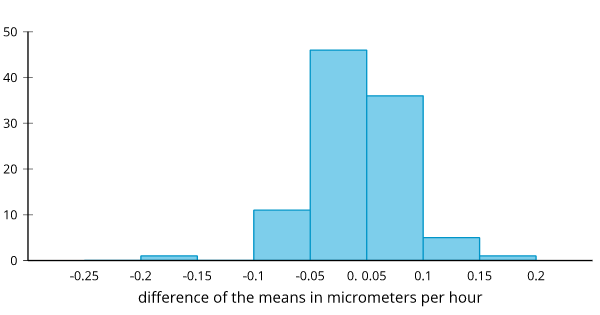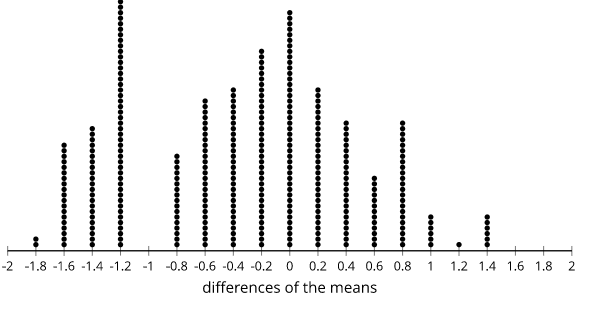Illustrative Math - Algebra 2 - Unit 7 - Lesson 13
By Formative Library
starstarstarstarstar
Last updated about 1 year ago
6 Questions
1
1.
A scientist is growing single-crystal diamonds in the laboratory using a standard process and a new process. The scientist wants to know which process causes the diamonds to grow faster. The mean growth rate for 20 diamonds grown using the standard process is 0.7 micrometers per hour. The growth rate for 20 diamonds grown using the new process is 0.9 micrometers per hour. The scientist uses simulations to get a randomization distribution to determine if the results happened by chance. The randomization distribution is displayed in the histogram.

Is it reasonable to conclude that the mean difference between the 2 groups occurred by chance? Explain your reasoning.
S.IC.5
S.IC.3

1
2.
1
3.
1
4.
The dot plot displays a randomization distribution based on 325 simulations redistributing data from an experiment.

Select all of the values that represent difference of the means where there is evidence to determine that the results are likely due to the treatment.
S.IC.5
S.IC.3
1
5.
An internet company uses a random sample of 200 internet users and simulations to estimate the proportion of people who stream videos. The company estimates the proportion is 0.853 with a margin of error of 0.081. They decide to check their results by collecting another random sample with 300 internet users.
Which of the results is most likely to be the estimates from the second random sample and simulations?
S.IC.5
S.IC.3
1
6.
Mai has a box of number cubes with each of the 6 faces marked with one of the numbers 1, 2, 3, 4, 5 and 6. She rolls one number cube and makes note of the number on the face that is facing up. After rolling this number cube 20 times, she notices that the number 4 appears nine times.
Mai suspects that this number cube is weighted in some way to make 4 appear more often than the other numbers. Using another number cube from the box that she has confirmed is fair (all of the numbers tend to be rolled with equal frequency), explain a process Mai could use to gather evidence to show whether this number cube is also fair.
S.IC.5
S.IC.3
This lesson is from Illustrative Mathematics. Algebra 1, Unit 7, Lesson 13. Internet. Available from https://curriculum.illustrativemathematics.org/HS/teachers/3/7/13/index.html ; accessed 29/July/2021.
IM Algebra 1, Geometry, Algebra 2 is © 2019 Illustrative Mathematics. Licensed under the Creative Commons Attribution 4.0 International License (CC BY 4.0).
The Illustrative Mathematics name and logo are not subject to the Creative Commons license and may not be used without the prior and express written consent of Illustrative Mathematics.
These materials include public domain images or openly licensed images that are copyrighted by their respective owners. Openly licensed images remain under the terms of their respective licenses. See the image attribution section for more information.